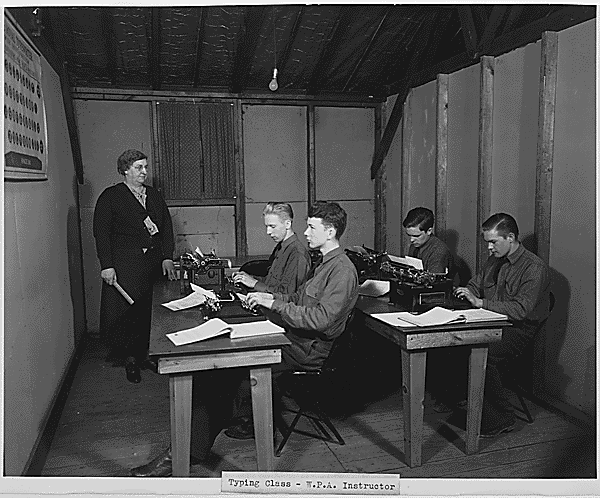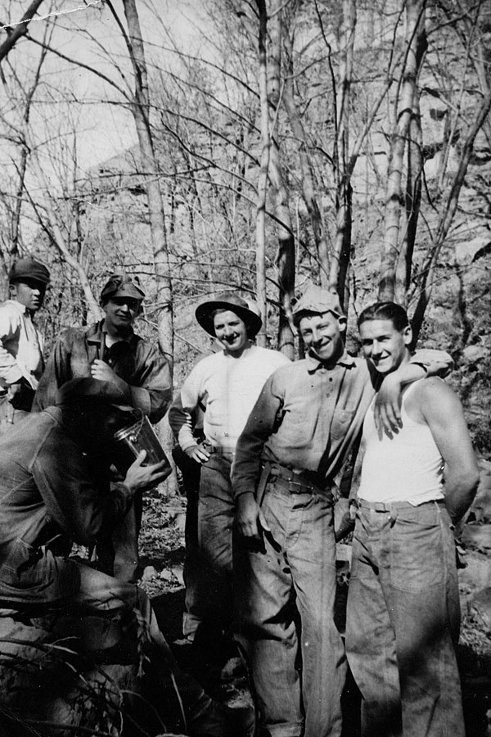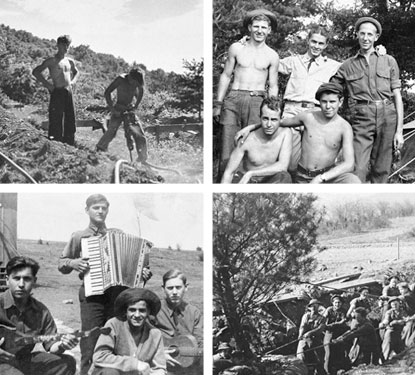
Source: National Parks Service
Editors Note: If you’ve ever been camping, you’ve probably hiked on a trail or used a lodge that was built by the Civilian Conservation Corps. But just what was the CCC? In this article, Philip Rodney Moon explains the origin of this New Deal program and it’s lasting effect on the land and the men who took part. Hopefully next time you walk across a bridge made by the CCC, you’ll take a moment to remember the hard working men who created a lasting legacy for future generations to enjoy.
Eighty years ago the nation was plunged into the Depression when the excesses of the 1920s caught up with society. Like the current recession, the economic bubble and collapse was the result of excessive debt spending by consumers and excessive risk taken on by investors. At the worst depths of the Depression 25% of the workforce was unemployed.
With such high unemployment and people with jobs suffering major pay cuts, many across the country suffered. Out in the Plains States years of poor farming practices, coupled with a severe drought, led to massive soil erosion and the Dust Bowl, leaving millions of fertile acres a wasteland.
The depression hurt young men especially. They had the fewest skills and the lowest earnings and savings, and many found themselves coming of age in a decade with high unemployment. They were at the greatest risk for poverty and starvation. Any sociologist will tell you that restless young men without a purpose will usually lead to social instability and skyrocketing crime rates.
President Franklin Roosevelt saw all these problems and sought ways to fix them. One of his “100 Days†programs he passed was the Emergency Conservation Work Act (ECW), a temporary program that would become the Civilian Conservation Corps (CCC). Roosevelt described the goals of the CCC when he introduced the legislation.
“I propose to create a civilian conservation corps to be used in simple work, not interfering with normal employment, and confining itself to forestry, the prevention of soil erosion, flood control, and similar projects. I call your attention to the fact that this type of work is of definite practical value, not only through the prevention of great present financial loss but also a means of creating future national wealth…More important, however, than the material gains will be the moral and spiritual value of such work. The overwhelming majority of unemployed Americans, who are now walking the streets and receiving private or public relief, would infinitely prefer to work. We can take a vast army of these unemployed out into healthful surroundings.”
The Civilian Conservation Corps Legacy puts it more succinctly: “Its purpose was two-fold — conservation of our natural resources and the salvage of our young men.â€
The program, which started out with 250,000 men, would eventually employ 3 million young men, Native Americans, WWI veterans throughout its nine year history. The CCC would go on to leave a legacy of restored natural beauty, economic sustenance for families across the country, and a generation of men made better for their experience.
Environmental Degradation
For years the American agricultural sector had grown in output and productivity. During World War I farmers grew more acres to supply the war effort and mechanized tractors and transportation changed how they farmed. Unfortunately, these new methods were exploitative and dangerous to the soil. Few farmers knew about crop rotation, fertilization, or techniques to prevent soil erosion. When a severe drought hit the central plains, the tired land dried up and blew away, resulting in significant loss of topsoil and farm acreage. This “Dust Bowl” devastated thousands of farming families.
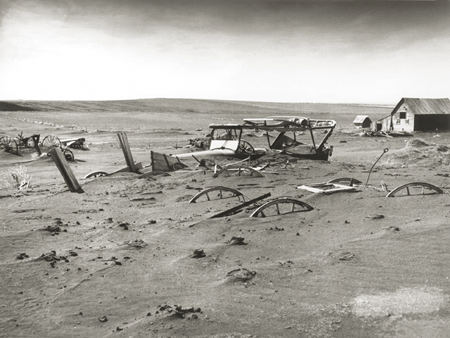 Dallas, South Dakota, 1936
Dallas, South Dakota, 1936
In other areas of the country, similar ecological problems existed. Clear cut logging had left land scarred and soil at risk. National parks that had been set aside hadn’t yet been fully developed for fire management or access to tourists. The environmental legacy of Theodore Roosevelt had been left to lie for years. His distant cousin Franklin Roosevelt would rise to the challenge of America’s environmental needs while tackling the problem of youth unemployment.
Logistics
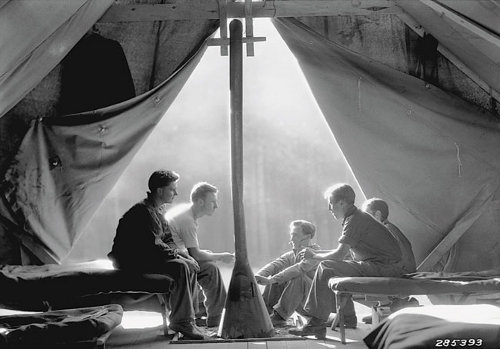
Several federal agencies would be involved in the running of the program, but the biggest influence was the Army. The Army was most capable of moving hundreds of thousands of young men into sites across all 48 states and several territories, setting up and supplying camps and getting the work done.
Most of the men in the program came from the urban areas of the East and were moved out West. Few had the experience of being in the wilderness, and many hadn’t ventured so far out from their homes. They signed up for six month enlistments, which could be extended for up to two years.
The camps, while not officially military, were run much in the same way as a base or boot camp. The young men were woken up early in the day to the reveille, roll was called, calisthenic drills were run, bunks were made and kept in order, and men were given their tasks for the day.
Benefits to the Men
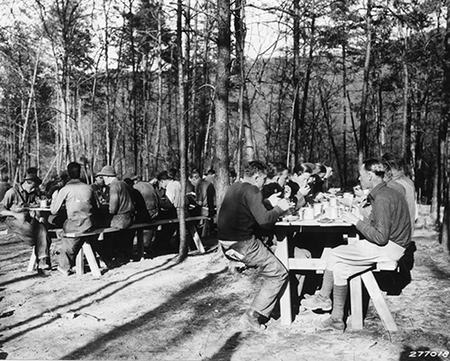 CCC Men Eating, Camp Roosevelt, VA
CCC Men Eating, Camp Roosevelt, VA
Source: Oregon State University
The men who signed up for the CCC were generally 17 to 25 years old, unemployed, unmarried, and not in school. Exceptions were made for World War I veterans in need of work, but the bulk were young men.
The pay for the work was low, at $1 a day (for contrast Ford introduced his generous $5 a day auto worker compensation in 1914, which was twice the average of $2.50). They earned $30 dollars a month, but $25 dollars of that was withheld and sent to support their families back home. That left them with $5 a month to spend on themselves in towns near their camps.
The men weren’t starving on those wages. In addition to their pay they got food, housing, clothing, and medical care provided. The men often found themselves eating better in the camps then they had ever eaten before. Several men from poor families hadn’t had access to good sources of meat, eggs and fresh vegetables like they received in the camps. In a visit to a camp in Shenandoah National Park, Roosevelt mentioned the good health of the members at the camp and how they had an average weight gain of twelve pounds, while he joked about how he wanted to take twelve pounds off himself.
In today’s world where obesity is an epidemic weight gain is seen as bad, but in the 1930’s malnutrition among the poor was a concern. 16% of the men drafted in World War II were disqualified for medical reasons and Major General Lewis B. Hershey would testify to Congress that malnutrition and underfeeding were the cause of 40-60% of those cases. The men in the camps gained healthy muscle weight and with their hard labor, medical care, and work outdoors they were healthier than they had been before.
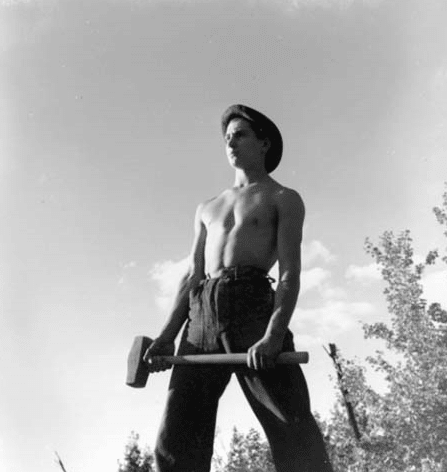
In addition to the financial and health benefits, the CCC offered educational benefits for the workers. Strong emphasis was put on insuring all CCC workers would leave literate. More than 40,000 men learned to read during their time with the CCC. Other work skills like carpentry, stone cutting, welding, truck driving, and typing were taught to fill the need for skilled craftsmen.
One CCC member explained the value the education had on the mentality of the men of the CCC.
“We were taught the idea that, hey, you can do things. You can do better than what you’ve done in the past. You have a future. And we believed that.†-Harley Jolley, North Carolina.
The greatest benefit to the young men was a sense of purpose the work gave them. No longer bumming around or hitting the rails in search of menial jobs, the men were learning the satisfactions of hard work and gaining valuable experience.
“We’re eating regular, we got clothes, they’re teaching us the way, and we were learning something,â€- Houston Pritchett, Detroit, Michigan.
Bonding with Their Fellow Men
 CCC Enlistees Play Football
CCC Enlistees Play Football
Source: Oregon State University
The camps weren’t all work. After a day of working 8-10 hours, the men would come back and have recreation time. In addition to opportunities for education, sports were an important part of camp life. It helped men bond and at times resolve their differences. When the men had a dispute they would often settle it in the boxing ring. The boxing ring also became a proving ground to new recruits who arrived in camp.
One CCC member described his arrival at a CCC camp in Shenandoah National Park:
“I went in, and there was a couple of boys sparring around with boxing gloves. And as I was walking down through the barracks, somebody said, “There’s a guy, let’s get him, give him them gloves.†And I got a good introduction right there… I didn’t get hurt any, but I, I had 4 or 5 people. My name was all over the Camp the next day.†– W. “Curley” Harvey, Corinth, West Virginia.
CCC Member Milton Knapp spoke of the CCC teams participating with other college and semi-pro teams in sports:
“I played baseball, basketball. Yeah we had a good baseball team. One year we wound up in, out in Kansas in the semi-pro league . . . And then we played basketball, we played different towns, and played uh, a lot of the college, in the college there, the fraternity brothers there. Yeah we had a pretty good baseball team. Our basketball team was average.†– Milton Knapp, East Peroria, Illinois
Far from home, having a unique experience together, CCC men formed friendships that would last a lifetime.
The Environmental Legacy Left Behind
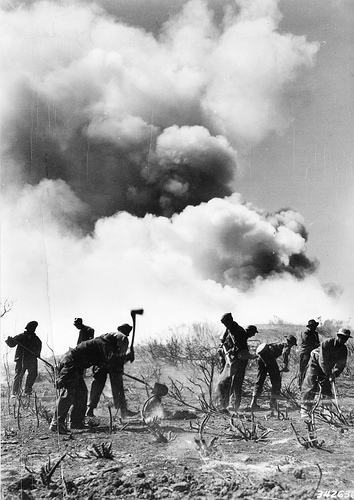 CCC Members Fight A Fire in Angeles National Forest, California
CCC Members Fight A Fire in Angeles National Forest, California
Source: Oregon State University
If a measure of a man is the legacy he leaves behind then the men of the CCC were not found wanting. The 3 million men unselfishly supported 12-15 million family members who received the checks sent home. Their work accomplishments were an even longer lasting legacy.
A sample of what they accomplished:
Number of Trees Planted: Between 2 and 3 billion
State Parks Developed: 800
Public Campground Development: 52,000 acres
Miles of Roads Built: 125,000
Miles of Telephone Lines Strung: 89,000
Miles of Foot Trails Built: 13,100
Farmlands Benefited from Erosion Control Projects: 40 million acres
Stream and Lake Bank Protection: 154 million square yards
Range Re-vegetation: 814,000 acres
Fire fighting Days: More than 8 million
Source: CCC Legacy
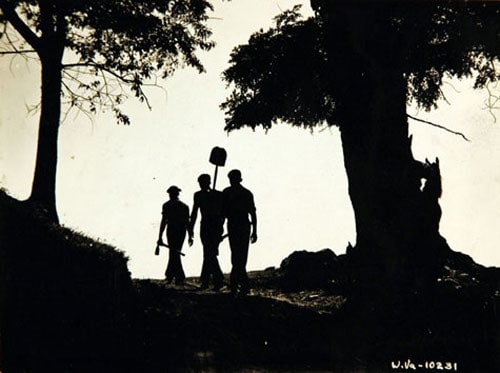
The End of the CCC and Its Contribution to the War
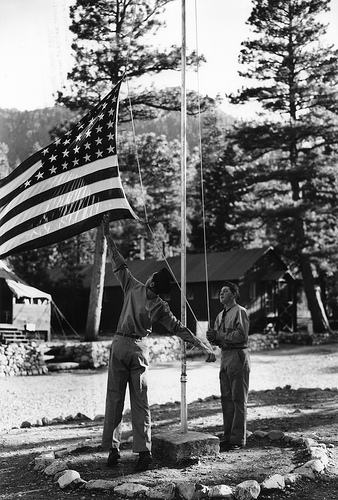 CCC Members Raise the American Flag
CCC Members Raise the American Flag
Source: Oregon State University
By the late 1930’s, the CCC was reaching the end of its life. While it remained a tremendously popular program, the bettering economy and military draft were lowering the unemployment rate and number of men signing up. The need to prepare for war taxed the budget and the Army’s resources. When Japan attacked Pearl Harbor on December 7th, 1941, the immediate needs of the war became apparent and militarization of the country would end the CCC.
The end of the Civilian Conservation Corp in 1941 would not be the end of its benefits to the nation. The 3 million men who participated would be among the most ready to join in the 16.1 million strong American force that would fight the Axis powers. Already versed in teamwork and discipline and inured to the strain of hard work, CCC men found the transition to military life to be an easy one.
CCC member W. “Curley†Harvey spoke about the benefit his time in the CCC had on his time in the military:
“What I learned in the CC Camp went a long ways with me. . . The army knows [that] practically everyone that was in the CC Camp made a heck of a lot better soldier†– W. “Curley” Harvey, Corinth, West Virginia.
Speaking at the Citadel, General Mark Clark argued that it wasn’t just the CCC men alone who benefited from the time in the CCC. The camps were run by military officers, who got a unique leadership experience that would test their abilities.
“At the same time, Military Officer personnel were being subtly trained for leadership. The CCC man was enrolled under a civilian Oath of Enrollment, and as such, was not subject to the articles of War or Courts Martial procedures. .. what a challenge this proved to be for military officers.â€
Military officers had to make the choice of either figuring out how to lead men without the force of military police and rules, or else face the shame of relying on civilian authorities to do the job for them. General Clark said that helped separate the good leaders from the bad and made for a better Army:
“Who knows but what the incompetents who we weeded out might otherwise have done later on in the War in places of responsibility where the lives of men were at stake.â€
The Greatest Legacy Of the CCC- The Men it Left Behind
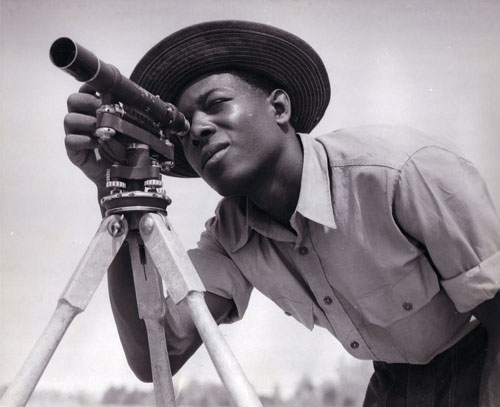
The great legacy of the CCC was the men it left behind. In its day the program was popular for its role in society. Unlike today’s battles over stimulus and jobs programs, the CCC received support from both sides of the aisle and people who otherwise opposed the president; it was supported by 67% of Republicans.
Several famous men would come out of the program.
Chuck Yeager – West Virginia CCC, joined the Army Air Corps during the war, rose to become Brigadier General, first man to break the sound barrier.
Robert Mitchum– Actor from film classics Cape Fear, Winds of War, Night of the Hunter
Norman Borlaug – CCC member who went on to lead the “Green Revolution†in agricultural, helping keep billions of people from starvation. For his efforts he was awarded the Nobel Peace Prize in 1970.
Walter Matthau – Actor and co-star with Jack Lemmon in such classic man films as the Odd Couple, The Fortune Cookie and Grumpy Old Men
Raymond Burr – Actor most famous for his role as the titular character in Perry Mason. Was active in the National Associations of Civilian Conservation Corps Alumni and successfully lobbied Congress to reinstate the program in 1984, though the program was then vetoed by President Reagan.
Source: CCC Legacy
General Mark Clark praised the program and the effect it had on the youth of the 1930s:
“In my way of thinking, the CCC was a monumental success in saving the youth of the 1930’s. . . endowing the individual CCC enrollee with a feeling of dignity, for he was giving his Country an honorable and worthwhile return for what it was doing for him and for his family economically – such a stark contrast to the shameful, character-robbing Welfare Programs of today.”
The Civilian Conservation Corps succeeded in its mission to conserve natural resources and salvage the unemployed youth. It took in millions of young boys and turned out men. CCC member Houston Pritchett explains it best.
“The CCC made me a man, made me respect discipline and how to work and how to get along with peopleâ€- Houston Pritchett, Detroit, Michigan
 CCC alumni Marion James is reflected in a plaque with the names of other men who worked at Camp 3422 in NC. (Photo by Lauren Carroll)
CCC alumni Marion James is reflected in a plaque with the names of other men who worked at Camp 3422 in NC. (Photo by Lauren Carroll)
_ _ _ _ _ _ _ _ _ _ _ _ __ _ _ __ _
To learn more about the CCC, I recommend watching Robert Stone’s documentary “The Civilian Conservation Corpsâ€, part of PBS’s American Experience series. This documentary is the source of the quotes from Houston Pritchett and Harley Jolley used in this article.
The CCC is also part of Ken Burns’ documentary The National Parks: America’s Best Idea


